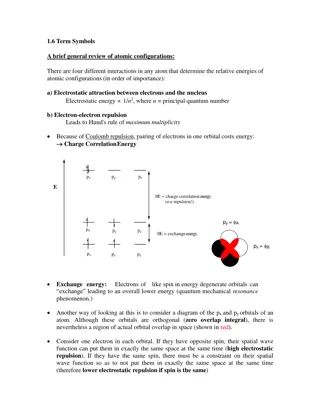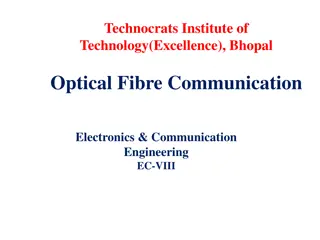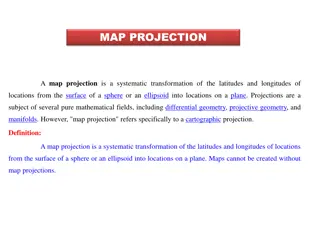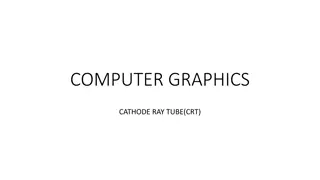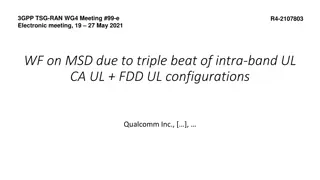Work Group meeting
This review project aims to assess the need for a special industry rule for trucking companies given the shift to market-based sourcing by the MTC. Factors prompting the review include distortion in applying the mileage approach, differences in revenue per mile among states, and the nature of taxpay
0 views • 21 slides
Advancements in Crystal Technology for Replacement of Electrostatic Septa
Crystal technology is being explored as a replacement for electrostatic septa in particle accelerators like the SPS at CERN. The transition aims to improve beam extraction efficiency and reduce radiation levels, impacting personnel safety and equipment lifespan. Various parameters and performance re
1 views • 17 slides
Understanding Atomic Configurations and Term Symbols
The energy of atomic configurations is determined by electrostatic attraction between electrons and the nucleus, electron-electron repulsion, spin-orbit coupling, and spin-spin interactions. Term symbols in electronic spectroscopy specify atomic states using quantum numbers. Hund's rule and the Paul
8 views • 12 slides
Chapter 5: Thermochemistry
Thermochemistry, as explored in Chapter 5 by Jennie L. Borders, delves into the study of energy and its conversions, focusing on various forms such as kinetic, potential, electrostatic, chemical, and thermal energy. The chapter discusses concepts like work, heat, and the nature of energy in relation
2 views • 56 slides
Understanding Hyperfine Interactions in Atomic Physics
Hyperfine interactions play a crucial role in atomic physics, leading to small energy shifts and splitting of degenerate levels in atoms and molecules. These interactions involve the electromagnetic multipole interactions between the nucleus and electron clouds, resulting in the splitting of energy
13 views • 154 slides
Understanding Optical Fiber Signal Degradation in Communication Engineering
Technocrats Institute of Technology (Excellence) in Bhopal delves into the concepts of signal degradation in optical fiber communication, focusing on attenuation, distortion mechanisms, and measurement techniques. The institute emphasizes the importance of signal attenuation and its impact on inform
4 views • 56 slides
Real-Time Digital Signal Processing Lab: Quantization and Resolution Overview
Explore quantization and resolution techniques in real-time digital signal processing. Topics include quantization error analysis, total harmonic distortion, noise immunity in communication systems, human sensory resolution, analog-to-digital conversion, and uniform amplitude quantization. Dive into
7 views • 19 slides
Spatial Distortion Correction in EPI Sequences: Field Mapping Examples
Spatial distortion artifacts in EPI sequences (BOLD or DWI) due to slow sampling rates in the phase encoding direction can be corrected using B0/spatial field mapping techniques. This correction requires obtaining field maps under the same B0 shimming conditions and with identical FoV and adjustment
0 views • 4 slides
New ILD Strategy: Consequences on ILD Tracking and Momentum Resolution
The ILD collaboration is adapting its strategy for potential circular colliders like FCC or CEPC, discussing challenges in tracking distortion correction, momentum resolution requirements, and handling various backgrounds. The focus is on optimizing the ILD design to meet the evolving collider lands
0 views • 11 slides
Understanding Map Projections: Types and Applications
Map projection is a systematic transformation of latitudes and longitudes from a curved surface to a flat plane. There are various classifications based on construction methods, tangent surface position, view point of light, and qualities like equal area and equi-distance. Zenithal Polar Equidistanc
0 views • 9 slides
Common Casting Defects in Prosthodontics: Causes and Prevention
Casting defects in prosthodontics can result from errors in the casting procedure, leading to issues like distortion, surface roughness, porosity, and incomplete detail. Various causes such as stress relaxation during wax pattern preparation can contribute to distortion, while factors like air bubbl
5 views • 27 slides
Exploring Energy Stores and Transfers in Science Lessons
Dive into the fascinating world of energy stores and transfers through engaging science lessons. Recall different energy stores, common energy transfers, and create flow diagrams to illustrate energy transfers in various scenarios. Explore gravitational, elastic, magnetic, electrostatic potential en
5 views • 9 slides
Understanding Cathode Ray Tube (CRT) Technology in Computer Graphics
Explore the technology of Cathode Ray Tube (CRT) used in traditional computer monitors and televisions. Learn about its components such as the electron gun, control electrode, focusing system, deflection yoke, and phosphorus-coated screen. Discover how a CRT works through the movement of electron be
1 views • 7 slides
Understanding Cathode Ray Tubes (CRT) in Oscilloscopes
Cathode Ray Tubes (CRTs) are key components in oscilloscopes, modulating and accelerating electron beams to create images of electrical waveforms, radar targets, and more. Unlike TVs, CRTs in oscilloscopes use electrostatic deflection for precise beam control. The electron gun assembly consists of a
0 views • 18 slides
Understanding Transmission Impairments in Computer Networks
Signals traveling through transmission media in computer networks can experience attenuation, distortion, and noise, leading to signal loss and changes in form or shape. Attenuation results in energy loss requiring amplification, while distortion alters the signal's composition. Engineers use decibe
1 views • 12 slides
Understanding Enzyme Catalysis and Active Site Role
Enzymes play a crucial role in catalyzing biochemical reactions by stabilizing transition states through their active sites. Different mechanisms like acid-base, covalent, metal, and electrostatic interactions are employed for stabilization. Acid-base catalysis involves acceleration without being co
1 views • 21 slides
Understanding Electrostatic Sensitive Devices (ESDS)
Electrostatic Sensitive Devices (ESDS) are susceptible to damage caused by electrostatic discharge (ESD). This results from the transfer of electrostatic charge induced by high electrical fields. ESD can alter the characteristics of semiconductor devices, leading to malfunctions or failures in elect
0 views • 34 slides
Understanding Central and Non-Central Forces in Physics
Newton's laws of motion introduced the concept of forces, leading to the classification of fundamental forces like gravitational, electromagnetic, strong nuclear, and weak nuclear forces. Central forces act toward or away from a fixed center, while non-central forces are affected by additional param
0 views • 7 slides
Comprehensive Guide to iCn3D Structure Viewer Features
Explore the diverse functionalities of iCn3D Structure Viewer through this detailed tutorial by Jiyao Wang, emphasizing H-Bonds, Interactions, Electrostatic Potential, Alternate Mutant, Wild Type, VAST+ Alignment, Multiple Chain Alignment, and more. Learn how to utilize different views, graphs, tabl
0 views • 17 slides
Physics Study Questions on Electric Charges and Forces
Delve into a series of multiple-choice physics questions related to electric charges and forces. Explore scenarios involving charged rods and objects, electrostatic forces between spheres, interactions between charged socks, experiments to determine charge, and conclusions drawn about the magnitudes
1 views • 42 slides
E-175 Fueling Procedures Training
Learn about the fueling procedures for Mesa Airlines, Inc.'s E-175 aircraft. Understand the importance of electrostatic bonding to prevent sparks during fueling operations. Discover the approved bonding locations on the E-175, tank specifications, fuel control panel features, and how to conduct auto
0 views • 24 slides
Physics Quiz Problems on Rivets, Coffee Pot, and Electric Charges
Solve challenging physics problems involving rivet cooling for a secure fit, coffee pot boiling time calculation, and electric charges on a square. The problems cover concepts such as thermal expansion, heat transfer, and electrostatic forces. Put your physics knowledge to the test with these though
0 views • 4 slides
Understanding Ions, Ionic Bonds, and Ionic Compounds
Ions are charged particles formed by gaining or losing electrons, leading to the formation of ionic bonds between positively charged cations and negatively charged anions. The octet rule guides electron configurations, and the periodic table helps predict ion formation. Ionic bonding involves electr
0 views • 13 slides
AnsCare Advanced Silicone Gel Formula with Vitamin C - Reduce Scars and Discoloration
AnsCare Silicone Gel with Vitamin C is a top international brand known for reducing hypertrophic scars, keloids, and bump scars caused by injuries or burns. The product contains 100% Medical Grade Silicone Gel with Vitamin C, which helps in minimizing scar discoloration. It is a self-drying, transpa
0 views • 21 slides
Understanding Coulomb's Law in Electrostatic Interactions
Coulomb's Law states that charges with the same sign repel each other, while charges with opposite signs attract. The strength of the electrostatic force between two particles is directly related to the amount of charge each possesses and inversely proportional to the square of the distance between
0 views • 24 slides
Understanding Electrostatic Discharge (ESD) in Precision Electronics
Explore the world of Electrostatic Discharge (ESD) and how it impacts precision electronics like op-amps and semiconductors. Learn about ESD generation, IC device sensitivity thresholds, ESD damage mechanisms, ESD protection methods, and device ESD robustness testing. Dive into the crucial aspects o
0 views • 33 slides
Innovations and Transformations in Condensed Matter Physics
Accelerating mainstream developments in condensed matter physics involves inducing electronic states and phases through strong external influences like electric or optical impacts. Notable successes include superconductivity manipulation and laser-induced transformations, with significant contributi
0 views • 38 slides
Understanding Time Distortion in Lockdown: Psychology and Routines
Being stuck at home during the lockdown due to the pandemic can lead to a distortion of our sense of time. The loss of routine and structure in our daily lives can make all days feel the same. This article explores the psychological reasons behind this phenomenon and offers suggestions on how to cre
0 views • 16 slides
Understanding Capacitors in Electric Circuits
Exploring various scenarios involving capacitors in electric circuits, from analyzing the electric field between capacitor plates to determining stored energy and capacitance differences. Topics covered include equilibrium charge distribution, potential energy comparison, and stability of interconne
0 views • 7 slides
Understanding Electrostatic Properties of Polyelectrolyte Solutions for DNA Molecules
Double-stranded DNA molecules exhibit repulsion due to their linear charge distribution, which can be mitigated by positively charged counter-ions. The Bjerrum length and Manning structural parameter play crucial roles in defining charge density. Electrostatic repulsion terms and calculations involv
0 views • 27 slides
Understanding Multisubstrate Enzyme Kinetic Mechanisms
In multisubstrate enzyme kinetic mechanisms, the apparent Km and Vmax values change with varying substrate concentrations. Different kinetic mechanisms like rapid equilibrium Bi Bi and ordered Bi Bi reactions can occur. The ping-pong Bi Bi reaction involves oscillation between enzyme forms. Various
0 views • 11 slides
Understanding Electrolyte Activity Coefficients and Equilibrium Constants
This article delves into the practical aspects of dealing with individual ions in aqueous solutions, particularly focusing on partitioning thermodynamic parameters between ions in salts. It explores the Debye-Hückel theory, which explains the electrostatic interactions between ions in solution and
0 views • 20 slides
Understanding Electret Microphones: Components, Mechanism, and Types
Electret microphones are a type of electrostatic capacitor-based microphone that eliminates the need for a polarizing power supply. They contain a permanently charged material known as an electret, which allows them to function without external power. This type of microphone has a built-in charge th
0 views • 8 slides
Understanding Forces: Types, Effects, and Measurement
Forces are interactions between objects that can be measured using spring scales in Newtons. They can be contact or non-contact, balanced or unbalanced, and include various types like tension, friction, magnetic, gravitational, electrostatic, and elastic spring force. Understanding forces helps expl
0 views • 4 slides
Understanding Electric Potential and Its Relationship to Electrostatic Energy
Electric potential is intricately linked to electrostatic potential energy, much like how electric field correlates to electrostatic force. The change in electric potential equals the change in electrostatic potential energy per unit positive test charge, expressed in volts. By exploring scenarios s
0 views • 24 slides
Analysis of Triple Beat Distortion in 3GPP TSG-RAN-WG4 Meeting #99-e
Analysis conducted during the electronic meeting of 3GPP TSG-RAN-WG4 focuses on the detection and impact of triple beat distortion in intra-band UL carrier aggregation and FDD UL configurations. The study delves into the mechanisms, causes, and effects of triple beat distortion on radio frequency si
0 views • 7 slides
Unraveling the Anomeric Effect: Origins and Mechanisms
The anomeric effect, discovered in 1955, reveals the preference of certain substituents in cyclohexyl systems to occupy the axial position. This phenomenon was first observed by J.T. Edward, N.-J. Chu, and R.U. Lemieux, challenging existing conceptions. The effect is attributed to hyperconjugation a
0 views • 10 slides
Understanding Ionic Bonding and Octet Rule in Chemistry
Understanding the concept of ionic bonding and octet rule in chemistry is essential for grasping how atoms combine to form molecules through sharing or exchanging electrons. This process involves the formation of positive and negative ions held together by electrostatic attraction, leading to the cr
0 views • 12 slides
Electrostatic Distortion Studies at SINP Kolkata and DESY
Studies on electrostatic distortion were conducted at SINP Kolkata and DESY, focusing on a Large Prototype TPC experiment with Bulk Micromegas modules. The experiments included varying electron beam energies, gas mixtures, cosmic ray data collection, drift velocity estimation, and more. Distortions
0 views • 7 slides
Understanding Forces and Their Applications
Forces are pushes or pulls that can cause objects to speed up, slow down, change direction, or shape. They are measured in newtons (N) using a newtonmeter. Various types of forces include contact, tension, electrostatic, friction, and gravitational forces. Forces always occur in pairs, with equal an
0 views • 46 slides


